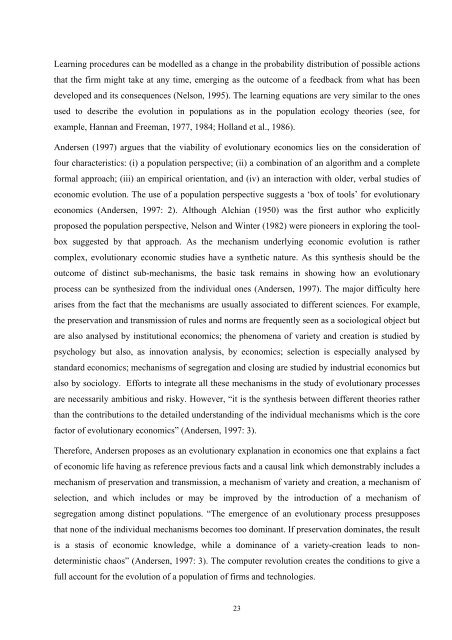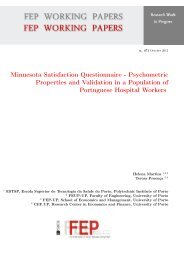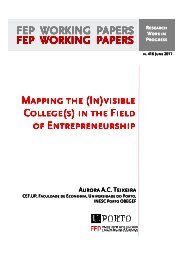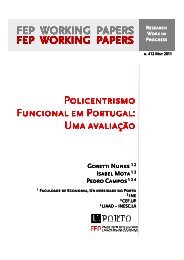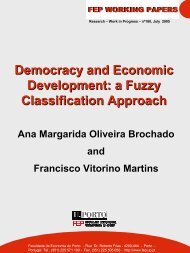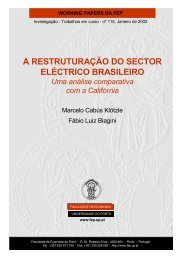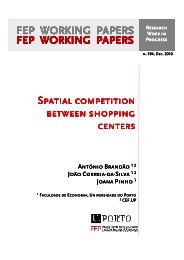Capa wps - FEP - Working Papers - Universidade do Porto
Capa wps - FEP - Working Papers - Universidade do Porto
Capa wps - FEP - Working Papers - Universidade do Porto
You also want an ePaper? Increase the reach of your titles
YUMPU automatically turns print PDFs into web optimized ePapers that Google loves.
Learning procedures can be modelled as a change in the probability distribution of possible actions<br />
that the firm might take at any time, emerging as the outcome of a feedback from what has been<br />
developed and its consequences (Nelson, 1995). The learning equations are very similar to the ones<br />
used to describe the evolution in populations as in the population ecology theories (see, for<br />
example, Hannan and Freeman, 1977, 1984; Holland et al., 1986).<br />
Andersen (1997) argues that the viability of evolutionary economics lies on the consideration of<br />
four characteristics: (i) a population perspective; (ii) a combination of an algorithm and a complete<br />
formal approach; (iii) an empirical orientation, and (iv) an interaction with older, verbal studies of<br />
economic evolution. The use of a population perspective suggests a ‘box of tools’ for evolutionary<br />
economics (Andersen, 1997: 2). Although Alchian (1950) was the first author who explicitly<br />
proposed the population perspective, Nelson and Winter (1982) were pioneers in exploring the toolbox<br />
suggested by that approach. As the mechanism underlying economic evolution is rather<br />
complex, evolutionary economic studies have a synthetic nature. As this synthesis should be the<br />
outcome of distinct sub-mechanisms, the basic task remains in showing how an evolutionary<br />
process can be synthesized from the individual ones (Andersen, 1997). The major difficulty here<br />
arises from the fact that the mechanisms are usually associated to different sciences. For example,<br />
the preservation and transmission of rules and norms are frequently seen as a sociological object but<br />
are also analysed by institutional economics; the phenomena of variety and creation is studied by<br />
psychology but also, as innovation analysis, by economics; selection is especially analysed by<br />
standard economics; mechanisms of segregation and closing are studied by industrial economics but<br />
also by sociology. Efforts to integrate all these mechanisms in the study of evolutionary processes<br />
are necessarily ambitious and risky. However, “it is the synthesis between different theories rather<br />
than the contributions to the detailed understanding of the individual mechanisms which is the core<br />
factor of evolutionary economics” (Andersen, 1997: 3).<br />
Therefore, Andersen proposes as an evolutionary explanation in economics one that explains a fact<br />
of economic life having as reference previous facts and a causal link which demonstrably includes a<br />
mechanism of preservation and transmission, a mechanism of variety and creation, a mechanism of<br />
selection, and which includes or may be improved by the introduction of a mechanism of<br />
segregation among distinct populations. “The emergence of an evolutionary process presupposes<br />
that none of the individual mechanisms becomes too <strong>do</strong>minant. If preservation <strong>do</strong>minates, the result<br />
is a stasis of economic knowledge, while a <strong>do</strong>minance of a variety-creation leads to nondeterministic<br />
chaos” (Andersen, 1997: 3). The computer revolution creates the conditions to give a<br />
full account for the evolution of a population of firms and technologies.<br />
23


